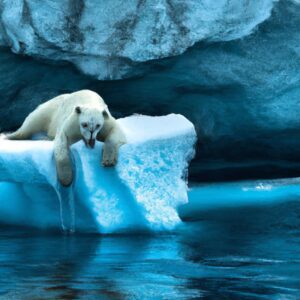Introduction
Climate change is one of the most pressing global environmental issues of our time. Despite its relatively recent emergence in popular discourse, it has been a real and present danger to biodiversity for many years. As temperatures continue to rise, species around the world face extinction, and habitats are being destroyed at an alarming rate. It is essential to understand the connection between climate change and biodiversity if we hope to take meaningful action to preserve endangered species and protect our planet in the future.
Definition of Biodiversity
Biodiversity, or biological diversity, is the variety of different kinds of living species on our planet. This includes animals, plants, fungi, and microorganisms that live together in a variety of habitats. Biodiversity is important for maintaining balance in our environment and is essential for our planet’s health as it plays a major role in providing us with food, air, and water. It also helps increase the resilience of the ecosystems we depend on.
Without biodiversity, the planet would not be able to sustain life as it does today. Biodiversity provides us with many benefits such as clean air, soil fertility, and a stable climate. It also helps us combat diseases, protects us from natural disasters, and improves our quality of life.
Climate Change Overview
Climate change is the result of long-term shifts in the Earth’s climate caused by human activities, natural events, and natural climatic variations. The primary cause of climate change is increased levels of carbon dioxide (CO2) and other greenhouse gases in the atmosphere due to human activities like burning fossil fuels and deforestation. As a result of this buildup, the Earth is trapping more heat from the sun, leading to an increase in global temperatures. These higher temperatures cause changes in weather patterns, sea levels, and ocean types.
Climate change has drastic impacts on biodiversity, leading to species extinction, disruption of habitats, and overall loss of ecosystems and food webs. It is essential to understand these effects in order to prevent further and irreversible damage to our planet.
Causes of Climate Change
Climate change is a global phenomenon that is caused by many different things. The three primary causes of climate change are human activities, natural events, and natural climatic variations. Human activities, like burning fossil fuels or cutting down forests, release contaminants into the atmosphere that cause temperatures to rise. Natural events, like volcanic eruptions and solar flares, also contribute to climate change by releasing ash and other pollutants into the atmosphere. Finally, natural climatic variations are when Earth’s atmosphere experiences higher than average temperatures due to natural cycles, like El Nino or La Nina.
Although these natural events contribute to climate change, it is human activities such as burning fossil fuels, deforestation, and urban sprawl that are the primary cause of the current climate crisis. It is important to understand the causes of climate change in order to take steps to reduce its effects.
Impact on Biodiversity
Climate change has a drastic and far-reaching impact on biodiversity. We can observe this in the form of different species, habitats, ecosystems, and food webs being affected by rising temperatures, droughts, melting ice, pollution, and other environmental changes.
Different species are being disrupted due to their inability to adapt to their changing environment, with some species going extinct, or having to migrate to new areas for survival. This affects the balance of nature as well as the food web, as entire species may be wiped out due to their lack of resilience against climate change.
Habitats are also being threatened, as rising sea levels lead to the destruction of important ecosystems, while rising temperatures are leading to the loss of natural vegetation. As the climate changes, plants and animals may no longer be able to survive in their current living environment, leading to an overall decrease in biodiversity.
Food webs are also being negatively impacted, as climate change has an effect on the interdependence between species. For example, certain species of animals may rely on the presence of a particular plant or insect species for food, which can lead to a decrease in the population size of the animal species if the plant or insect is no longer found.
Ecosystems and Food Webs
Climate change has immense effects on the world’s ecosystems and food webs. These changes can occur quickly or slowly, but they all have a profound impact on the environment. The effects of climate change include:
- Pollution – Pollutants, such as smog and chemicals, are released into the air and water due to human activities like burning fossil fuels. This harms aquatic and terrestrial life, as well as the overall environment.
- Drought – As temperatures rise, droughts become more common and cause water shortages, which can lead to a decrease in biodiversity.
- Rising Sea Levels – Warmer temperatures accelerate the melting of glaciers in polar regions, thus causing sea levels to rise rapidly. This can displace coastal habitats and therefore endanger species living in these areas.
These changes in ecosystems and food webs cause species to go extinct or move to new habitats and disrupt the balance of species’ populations. Human activities are the primary cause of climate change, so it is difficult for species to adapt to the changes brought on by this phenomenon.
Species Disruption
Climate change has a massive impact on the wildlife of our planet. As temperatures rise and habitats change, species must adapt to their new environments or risk going extinct. Many species are struggling to keep up with the rapid changes caused by global warming, leading to disruptions in food webs, ecosystems, and even the extinction of certain species.
Warmer oceans are causing a shift in fish populations, which is disrupting the delicate balance between predators and their prey. Species that require specific conditions to survive are becoming increasingly vulnerable as the climate changes, such as polar bears, coral reef fish, and alpine plants. High temperatures also cause extreme weather events like droughts and floods, which can decimate entire populations of plants and animals.
The disruption of species is not only making it difficult for them to survive, but is also devastating the environment they inhabit. Without their predators, certain species could become overpopulated, while without their prey, another species could face starvation. This kind of disruption can have far-reaching consequences, not only for the species involved, but also for the entire ecosystem.
Loss of Habitats
Climate change is causing habitats to be lost at an alarming rate. This can leave species struggling to find places to call home while also making it harder for them to adapt and survive due to the changing environmental conditions. Rising sea levels, extreme temperatures, and drier conditions are all creating new problems for ecosystems around the world.
For instance, coral reefs are struggling to survive in waters that are increasingly acidic due to higher temperatures. Trees are also being uprooted as deforestation continues, making it harder for birds, rodents, and other species to find shelter. These losses mean that biodiversity is decreasing and plants and animals are not able to find suitable homes and niches within their respective ecosystems.
It is important to note that we can take action to address the problem of habitat loss. Replanting forests, conserving wetlands, and reducing air pollution can help to create more resilient ecosystems that are better able to cope with the changing climate. Additionally, understanding the impacts of climate change on biodiversity can help us to better protect habitats and the species that live within them.
Solutions & Adaptations to Tackle Biodiversity Loss
The challenges posed by climate change on biodiversity can be daunting. However, there are a few solutions and adaptations that can help us address these issues.
One such adaptation is carbon offsetting. This involves reducing greenhouse gas emissions by replacing them with green energy sources, such as renewable energy or carbon-neutral materials like bamboo. Additionally, carbon offsetting can be achieved through afforestation, reforestation, and other preservation efforts, all of which promote environmental health.
Another approach is sustainable development. This involves creating initiatives that support communities and ecosystems without negatively impacting the environment. Examples include sustainable agriculture, responsible forestry, and eco-tourism that develop the natural environment without undermining it. Such strategies not only seek to lessen the impact of climate change, but also enable communities to become part of the solution rather than contributing to the problem.
While the challenges posed by climate change can seem overwhelming, solutions and adaptations do exist. With the right planning, research, and resources, we can protect our biodiversity and ensure a thriving planet for generations to come.
Human Regulation
Humans are often unable to handle the powerful forces of nature on their own, and due to the scope of climate change’s impacts on biodiversity, require government regulation and policy changes in order to address these threats. We cannot rely solely on ourselves to create solutions that preserve what we value most about our ecosystems – the diversity of plants, animals, and resources that keep the planet alive.
The effects of climate change are already far-reaching, with rising temperatures, sea levels, and carbon dioxide levels putting countless species at risk of displacement or extinction. Governments around the world have started to recognize these dangers and are implementing policies to reduce carbon emissions and promote sustainable development. For example, countries like China are investing in renewable energy sources like solar and wind while others, such as the United States, are exploring ways to capture and store carbon dioxide. These initiatives are necessary to help prevent further damage from climate change.
Environmental protection laws are also being developed by governments in order to protect endangered species and habitats from further destruction. By creating refuge areas, regulating certain activities, and controlling pollution, governments can help protect species from extinction. In addition, organizations like the World Wildlife Fund are advocating for the adoption of laws to protect valuable ecosystems, such as mangrove forests, coral reefs, and tropical rainforests.
In order to effectively address the impact of climate change on biodiversity, governments must create and enforce regulations that protect natural habitats and promote responsible resource use, while also investing in renewable energy sources and innovative technologies like carbon capture and storage. It is only through thoughtful policy changes and global collaboration that humanity can reverse the damage to our planet’s biodiversity, and ensure that our ecosystems remain diverse and healthy.
Climate change is an ever-increasing issue that is having a real and tangible effect on our planet’s biodiversity. From the polar ice caps melting and sea levels rising to species shifting habitats and going extinct, the ripple effects of climate change are being felt around the world and are endangering the diverse ecosystems they inhabit. While the causes of climate change include both human and natural events, it is our responsibility as humans to research, adapt, and take the necessary actions to protect our planet from further damage. Solutions such as carbon offsetting and sustainable development can help reduce the emissions that contribute to climate change and aid species in their quests for adaptation. Additionally, governments can play a crucial role in implementing regulations and policies to protect the biodiversity of our planet. Our current climate crisis is an urgent one, but by understanding its impacts on biodiversity, utilizing available solutions, and working together to make lasting policy changes, we can make a positive impact on the future of our environment.
Works Cited
In this guide, we have discussed the impact of climate change on biodiversity, the causes of climate change, the disruption to species and ecosystems, and the ways in which humans can help protect against the loss of biodiversity. In order to provide the most accurate information, we need to cite our sources.
Below is a list of sources used throughout this guide:
- National Wildlife Federation. “Climate Change and Biodiversity.” Accessed March 17, 2021. https://www.nwf.org/Our-Work/Climate-and-Energy/Climate-Change/Impacts-and-Solutions/Biodiversity
- World Wildlife Fund. “How Does Climate Change Affect Biodiversity?” Accessed March 17, 2021. https://www.worldwildlife.org/stories/how-does-climate-change-affect-biodiversity
- United Nations Framework Convention on Climate Change. “Understanding Climate Change.” Accessed March 17, 2021. https://unfccc.int/topics/understanding-climate-change/
- Environmental Protection Agency. “Climate Change Impacts on Biodiversity.” Accessed March 17, 2021. https://www.epa.gov/climate-change-impacts/climate-change-impacts-biodiversity
comments: 0











